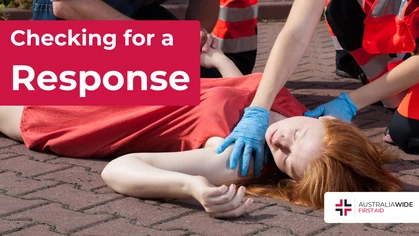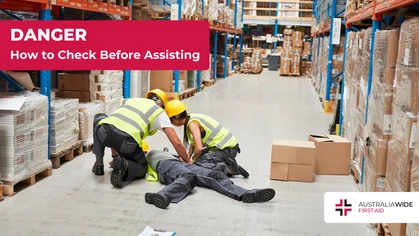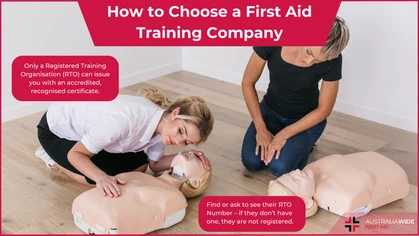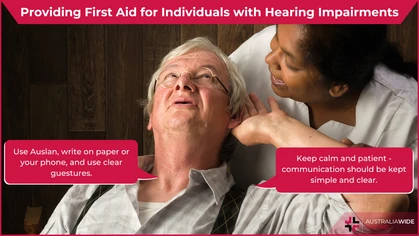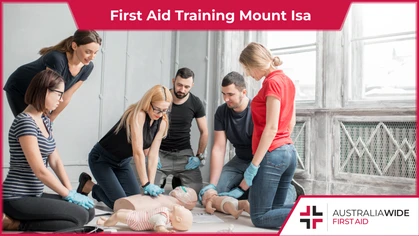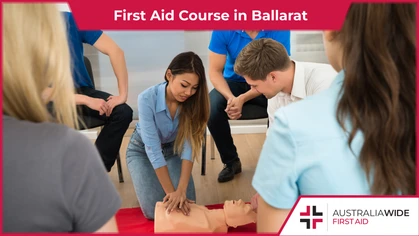Stroke First Aid

First Aid Training
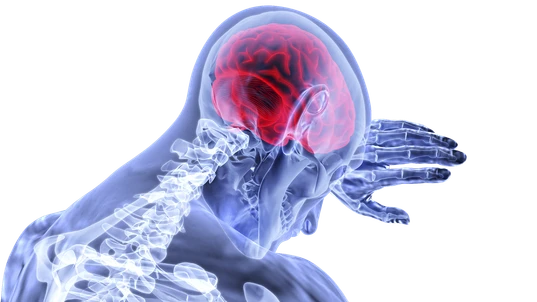
Strokes vary in intensity and can affect different areas of the brain, causing problems with hearing, vision, speaking, memory & muscle strength. At the first sign of stroke, call for an ambulance immediately.
A stroke is a medical emergency that can have severe repercussions. If you suspect a stroke, time is of the essence, so do not delay in calling 000 for medical emergency services. First aid treatment for a stroke casualty aims to keep the victim as stable and comfortable as possible until emergency services arrive and take over.What to do if someone is having a stroke?
Strokes can affect the way a person thinks, as well as their emotions. Strokes vary in intensity and can affect different areas of the brain, causing problems with hearing, vision, speaking, memory, and muscle weakness. If a person shows even one sign in the F.A.S.T. test below, call Triple Zero (000) straight away. Prompt action can prevent further damage to the brain and help the casualty make a full recovery. Delay in getting treatment can result in death or major long-term disabilities. While waiting for the ambulance, consult the following treatment plan:- Help the casualty adopt a position of comfort, while also ensuring that their airway remains unobstructed, and their body temperature remains normal.
- Talk to the casualty reassuringly, even if they are unconscious.
- If the casualty is or becomes unconscious, but is breathing normally, move them into the recovery position.
- Constantly observe for signs of deterioration – if they do stop breathing normally, follow DRSABCD and prepare to perform CPR.
What is a stroke?
A stroke occurs when the blood supply to a part of the brain is suddenly disrupted. This can cause brain cells to die, as they rely on blood to receive life-sustaining oxygen and nutrients. If a stroke victim does not receive prompt medical treatment, whole swathes of their brain can die, and they can sustain permanent brain damage and requisite physical, emotional, and intellectual complications. Strokes can occur in three primary forms, each of which have their own individual causes:- Haemorrhagic strokes occur when a blood vessel ruptures and leaks blood into or around the brain, which suffocates the soft brain tissue.
- Ischaemic strokes occur when an artery that supplies blood to a part of the brain is blocked by an embolism or atherosclerosis, which can lead to permanent scarring on the brain and impaired functioning.
- Transient ischaemic attacks (TIAs) also occur when an artery that supplies blood to a part of the brain is blocked, albeit temporarily.
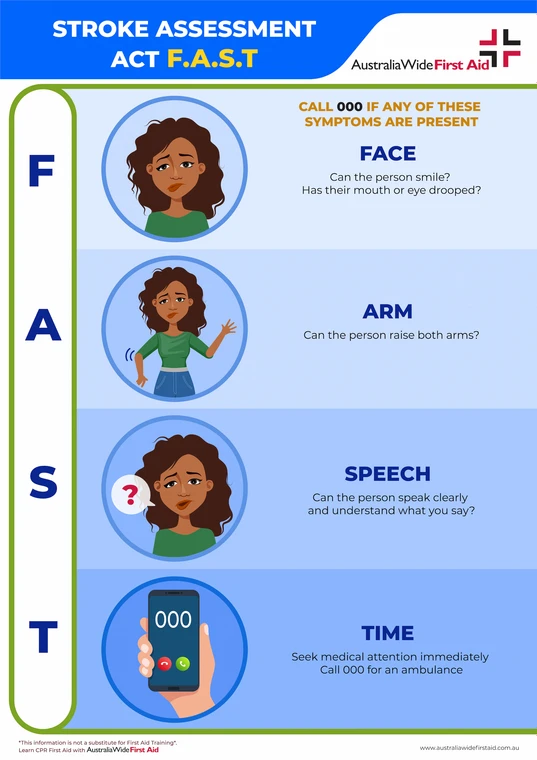
The Stroke Foundation recommends using the F.A.S.T test to remember the main symptoms of stroke, and to assess whether a person is experiencing a stroke.
What are the signs of a stroke?
Stroke
The Stroke Foundation recommends using the F.A.S.T test to remember the main symptoms of stroke. As cited by the American Stroke Association, the acronym F.A.S.T represents:- F = Face Drooping: Does one side of the face droop or is it numb? Ask the person to smile. Is the person’s smile uneven?
- A = Arm Weakness: Is one arm weak or numb? Ask the person to raise both arms. Does one arm drift downward?
- S = Speech Difficulty: Is speech slurred?
- T = Time to call Triple Zero (000) if you see any of these signs.
What does a stroke feel like?
The classic symptoms of a stroke begin suddenly and are pronounced. They include:- Weakness, numbness, or paralysis in other parts of the body, either on one or both sides.
- Blurred vision or loss of vision in one or both eyes.
- A sudden and severe headache with no known cause.
- Dizziness, loss of balance, or an unexplained fall.
- Difficulty swallowing, speaking, or understanding.
How long does a stroke last?
Stroke symptoms will typically last more than 24 hours. Some stroke symptoms may or may not resolve, even with therapy. TIA symptoms last only briefly, resolving in about 1 to 5 minutes. Less frequently, they can take up to 24 hours to resolve. A stroke is often a frightening event that can leave its victim shaken and confused. Added to that are the long-term effects such as impaired or permanent loss of function. Often a stroke is a life-changing event that requires the person to re-learn basic functions. Stroke experiences vary and the long-term effects they cause can likewise vary greatly depending on which side of the brain was affected. Prompt treatment and rehabilitation can aid in recovery and improve the chances of regaining bodily function. The emotional impact of stroke also takes its toll. Speaking, with friends, family, a therapist, or a support group will also aid in the recovery process.How is stroke treated?
At the hospital, the stroke patient would have a CT scan, MRI, or other imaging test, to rule out other possibilities, such as a brain tumour or drug reaction. For ischaemic stroke, medication would be given to break up clotting. This medication — recombinant tissue plasminogen activator (r-tPA, also called alteplase or Activase) — needs to be given intravenously within 4.5 hours of when symptoms started. Doctors can also use endovascular therapy to treat ischaemic strokes directly within the blocked blood vessel.- An injection of r-tPA directly where the stroke is happening is also possible — entering via a thin tube (catheter) inserted in an artery in the groin and threaded through to the brain.
- A device attached to a catheter could also be used to directly remove the clot from the blocked blood vessel. This procedure is preferred where large clots can't be dissolved with r-tPA.
Treatment options include:
- Drugs may be given to reduce pressure in the brain (intracranial pressure), lower blood pressure, prevent blood vessel spasms, and prevent seizures. When a patient has been on blood thinners, drugs or transfusions of blood products may be given to counteract the effects.
- Surgery may be needed to remove blood and relieve pressure on the brain. Surgery to repair blood vessel problems associated with haemorrhagic strokes could also be used. Doctors may recommend such procedures if an aneurysm, arteriovenous malformation (AVM), or other type of blood vessel problem caused the haemorrhagic stroke.
- Surgical clipping involves placing a small clamp at the base of the aneurysm, to stop blood flow to it and prevent the aneurysm from bursting. It could also prevent an aneurysm that recently haemorrhaged from bleeding again.
- Coiling (endovascular embolization) involves placing tiny detachable coils into the aneurysm to block blood flow and cause the blood to clot. This is done via a catheter inserted into an artery in the groin.
- Surgical AVM (arteriovenous malformation) removal, to eliminate the risk of rupture and lower the risk of haemorrhagic stroke, is possible where the AVM is smaller and in an accessible area of the brain. It's not always possible to remove a large or less accessible AVM, as doing so would have too severe an impact on brain function.
- Stereotactic radiosurgery is an advanced, minimally invasive treatment, that uses multiple beams of focused radiation to repair blood vessel malformations.
Is there an increased risk for secondary stroke?
Unfortunately once someone has experienced a stroke, they are at a higher risk for a secondary stroke. Secondary stroke can have even more devastating effects than the first and increases the chances of death. The risk of experiencing secondary stroke is highest in the following few days after the initial stroke and remains increased especially during the first year and up to five years. Taking steps for preventing any future stroke is crucial to ones survival. Disclaimer: This article is for informational purposes only. It does not constitute, replace, or qualify as any form of first aid training.Other Resources
For more information about the risk factors and signs of stroke, check out the National Stroke Foundation and their annual awareness campaigns, including National Stroke Week. The resources listed below are also useful for managing a variety of out-of-hospital emergencies:
Originally published at
https://www.australiawidefirstaid.com.au/resources/stroke-first-aid
as part of the Australia Wide First Aid Articles Library
